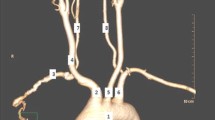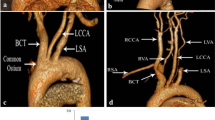Abstract
Branching pattern of aortic arch (AA) has a direct impact on the outcomes of thoracic surgical and angiographic procedures. Since, geographical variations in the branching pattern of AA have been described, this descriptive cross-sectional study describes the AA variations in a Sri Lankan population compared to the available global data. For that, contrast-enhanced computed tomographic studies (CTC) of thorax (n = 219) performed in males (49.3%) and females (50.7%), aged 59 ± 17 years (range: 4 to 96 years), were evaluated. Branching patterns of AA were categorized into seven types as described by Popieluszko et al. Only, four AA types were identified in the study population: type 1 (90%; n = 197), type 2 (n = 10, 4.6%), type 3 (n = 8, 3.7%), and type 6 AA (n = 4; 1.8%). The prevalence of AA variations was 10%. Type 1 AA was the most prevalent pattern in both genders: female, 91%; males, 88.9%. The most prevalent AA variant in females was type 2 (n = 6; 5.4%); males type 3 (n = 5; 4.6%). However, the branching pattern of AA has not demonstrated a significant gender influence (odds: 0.792; 95% CI: 0.327–1.917; p = 0.605). Variations in branching pattern of AA are as high as 10% among Sri Lankans. Thus, an in-depth knowledge on population specific prevalence of AA variants would influence the modifications of surgical approaches and the choice of angiographic catheters to be utilized, which in turn would minimize inadvertent vascular injuries during thoracic surgical and angiographic interventions.




Similar content being viewed by others
Data Availability
Data will be published in Mendeley.
Code Availability
Not applicable.
References
Priya S, Thomas R, Nagpal P, Sharma A, Steigner M. Congenital anomalies of the aortic arch. Cardiovasc Diagn Ther. 2018;8:S26–44. https://doi.org/10.21037/cdt.2017.10.15.
Sadler TW. Langman medical embryology. 14th ed. USA: Walters Kluwer; 2018.
Schoenwolf GC, Bleyl SB, Brauer PR, Francis-West PH, Philippa H. Larsen’s human embryology. 5th ed. Edinburgh: Churchill Livingstone; 2015.
Balaban Y. Effectiveness of a handmade “NEW CAROTID CATHETER” in trans radial carotid angiography : a comparison with conventional multipurpose catheters. J Interv Cardiol. 2018;31:94–105. https://doi.org/10.1111/joic.12454.
Ahn SH, Prince EA, Dubel GJ. Basic Neuroangiography : review of technique and perioperative patient care. Semin intervent Radiol. 2013;212:225–33.
Knox JA, Alexander MD, McCoy DB, Murph DC, Hinkly PJ, Chang JC, et al. Impact of aortic arch anatomy on technical performance and clinical outcomes in patients with acute ischemic stroke. Am J Neuroradiol. 2020;41:268–673.
Popieluszko P, Henry M, Sanna B, Hsieh C. A systematic review and meta-analysis of variations in branching patterns of the adult aortic arch. J Vasc Surg. 2017. https://doi.org/10.1016/j.jvs.2017.06.097.
Poyyamoli S, Swamiappan E, Gandhi J, Ranasingh RK, Cherian MP, Mehta P. Non-aortic vascular findings on chest CT angiogram: including arch vessels and bronchial arteries. Cardiovasc Diagn Ther. 2019;9:S59–73. https://doi.org/10.21037/cdt.2018.09.05.
Diehm N, Herrmann P, Dinkel HP. Multi detector CT angiography versus digital subtraction angiography for aortoiliac length measurements prior to endovascular AAA repair. J Endovasc Ther. 2004;11:527–34. https://doi.org/10.1583/03-1172.1.
Budhiraja V, Rastogi R, Jain V, Bankwar V, Raghuwanshi S. Anatomical variations in the branching pattern of human aortic arch : a cadaveric study from Central India. ISRN Anatomy. 2013: 828969 https://doi.org/10.5402/2013/828969
Qiu Y, Wu X, Zhuang Z, Li X, Zhu L, Huang C, et al. Anatomical variations of the aortic arch branches in a sample of Chinese cadavers: embryological basis and literature review. Interact CardioVasc Thorac Surg. 2019;28:622–8.
Lale P, Toprak U, J GY, Kaya T, Sad J, Uyan A. Variations in the branching pattern of the aortic arch detected with computerized tomography angiography. Advances in Radiology. 2014:969728. https://doi.org/10.1155/2014/969728
Keet K, Gunston G, Alexander R. Variations in the branching pattern of the aortic arch: an African perspective. Eur J Anat. 2019;23:91–102.
Wang L, Zhang J, Xin S. Morphologic features of the aortic arch and its branches in the adult Chinese population. J Vasc Surg. 2016;6:1602-1608.e1. https://doi.org/10.1016/j.jvs.2016.05.092.
Mylonas SN. Prevalence of bovine aortic arch variant in patients with aortic dissection and its implications in the outcome of patients with acute type b aortic dissection. Eur J Vasc Endovasc Surg. 2018;55:385–91. https://doi.org/10.1016/j.ejvs.2017.12.005.
Nayak SR, Pai MM, Prabhu LV, D’Costa S, Shetty P. Anatomical organization of aortic arch variations in the India: embryological basis and review. J Vasc Bras. 2006;5:95–100. https://doi.org/10.1590/s1677-54492006000200004.
Kondori JB, Asadi MH, Rahimian E, Tahsini MR. Anatomical variations in aortic arch branching pattern. Arch Iran Med. 2016;19:72–4.
Arazinska A, Polguj M, Szymczyk K, Kaczmarska M, Trebinski Ł, Stefańczyk L. Right aortic arch analysis – anatomical variant or serious vascular defect? BMC Cardiovasc Disord. 2017;17:102. https://doi.org/10.1186/s12872-017-0536-z.
Pandian DK, Radha K, Sundaravadhanam KVK. Study on branching pattern of arch of aorta in south Indian population. Int J Anat Res. 2014;2:673–6.
Rekha P, Senthikumar S. A study on branching pattern of human aortic arch and its variations in south Indian population. J Morphol Sci. 2013;30:11–5.
Tayal R, Khakwani MZ, Lesar B, Sinclair M, Emporelli A, Spektor V, et al. Takeoff orientation of the major aortic arch branches irrespective of arch type : ramifications for brachiocephalic interventions including carotid stenting. Sage Open Med. 2018;6:1–6. https://doi.org/10.1177/2050312118776717.
Hanneman K, Newman B. Congenital variants and anomalies of the aortic arch. Radiographics. 2017;37:32–51.
Karacan A, Türkvatan A, Karacan K. Anatomical variations of aortic arch branching: evaluation with computed tomographic angiography. Cardiol Young. 2014;24:485–93. https://doi.org/10.1017/S1047951113000656.
Molz G. Aberrant right subclavian arteries: predominance in females. Basic Res Cardiol. 1976;71:420–7.
Crowhurst JA, Whitby M, Thiele D, Halligan T, Westerink A, Crown S, Jillian M. Radiation dose in coronary angiography and intervention: initial results from the establishment of a multi-centre diagnostic reference level in Queensland public hospitals. J Med Radiat Sci. 2014;61:135–41. https://doi.org/10.1002/jmrs.67.
Funding
Self-funded.
Author information
Authors and Affiliations
Contributions
I Kodikara: Project development, data management, data analysis, manuscript writing and editing.
D Gamage: study design, data collection, data analysis.
S de Soyza: data collection, manuscript editing.
I Ilayperuma: project supervision, manuscript editing.
Corresponding author
Ethics declarations
Ethics Approval
Ethical approval for the study was obtained from the Ethical Review Committee of Kotelawala Defense University of Sri Lanka (RP/2018/13).
Consent to Participate
Not applicable in this retrospective study.
Consent for Publication
Not applicable.
Conflict of Interest
The authors declare no competing interests.
Additional information
Publisher's Note
Springer Nature remains neutral with regard to jurisdictional claims in published maps and institutional affiliations.
This article is part of the Topical Collection on Imaging
Supplementary Information
Below is the link to the electronic supplementary material.
Rights and permissions
About this article
Cite this article
Kodikara, I., Gamage, D., De Soyza, S. et al. Computed Tomographic Analysis of Aortic Arch Branching Patterns: Revisited. SN Compr. Clin. Med. 4, 17 (2022). https://doi.org/10.1007/s42399-021-01112-x
Accepted:
Published:
DOI: https://doi.org/10.1007/s42399-021-01112-x




